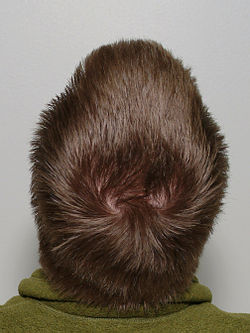Scalp hair
| Scalp | |
|---|---|

Illustration depicting the layers of the scalp and meninges
|
|
 |
|
| Details | |
| Artery | supratrochlear, supraorbital, superficial temporal, occipital |
| Vein | superficial temporal, posterior auricular, occipital |
| Nerve | supratrochlear, supraorbital, greater occipital, lesser occipital |
| Lymph | occipital, mastoid |
| Identifiers | |
| Latin | scalpus |
| MeSH | A01.456.810 |
| FMA | 46494 |
|
Anatomical terminology
[]
|
|
The scalp is the anatomical area bordered by the face at the front, and by the neck at the sides and back.
The scalp is usually described as having five layers, which can conveniently be remembered as a mnemonic:
The clinically important layer is the aponeurosis. Scalp lacerations through this layer mean that the "anchoring" of the superficial layers is lost and gaping of the wound occurs; this requires suturing. This can be achieved with simple or vertical mattress sutures using a non-absorbable material, which are subsequently removed at around days 7-10.
The blood supply of the scalp is via five pairs of arteries, three from the external carotid and two from the internal carotid:
Because the walls of the blood vessels are firmly attached to the fibrous tissue of the superficial fascial layer, cut ends of vessels here do not readily retract; even a small scalp wound may bleed profusely.
Innervation is the connection of nerves to the scalp: the sensory and motor nerves innervating the scalp. The scalp is innervated by the following:
The innervation of scalp can be remembered using the mnemonic, "Z-GLASS" for, Zygomaticotemporal nerve, Greater occipital nerve, Lesser occipital nerve, Auriculotemporal nerve, Supratrochlear nerve and Supraorbital nerve.
Lymphatic channels from the posterior half of the scalp drain to occipital and posterior auricular nodes. Lymphatic channels from anterior half drain to the parotid nodes.The lymph eventually reaches the submandibular and deep cervical nodes .
The scalp plays an important role in the aesthetics of the face. Androgenic alopecia, or male pattern hair loss, is a common cause of concern to men. It may be treated with varying rates success by medication (e.g. finasteride, minoxidil) or hair transplantation. If the scalp is heavy and loose, a common change with ageing, the forehead may be low, heavy and deeply lined. The brow lift procedure aims to address these concerns.
All the current hair transplantation techniques utilize the patient's existing hair. The aim of the surgical procedure is to use such hair as efficiently as possible. The right candidates for this type of surgery are individuals who still have healthy hair on the sides and the back of the head in order that hair for the transplant may be harvested from those areas. Different techniques are utilized in order to obtain the desired cosmetic results; Factors considered may include hair color, texture, curliness, etc.
...
Wikipedia
